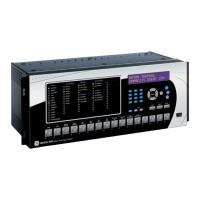5-154 M60 Motor Protection System GE Multilin
5.6 GROUPED ELEMENTS 5 SETTINGS
5
If MOTOR START INHIBIT MARGIN is greater than “0”, but relay does not contain records for five successful starts, then the
MOTOR START INHIBIT operand can be asserted again either when motor is tripped by thermal protection
(TCU = 100%) or tripped/stopped by any other reason (TC
accumulated
< 100%). However, operand reset is evaluated
based on 15% level of thermal capacity. To calculate the thermal lockout time in this case, the following values of TCU
are to be applied to the above equation: TCU
start
= thermal capacity accumulated from the moment the motor was
stopped, and TCU
end
= 15%.
• VOLTAGE DEPENDENT FUNCTION: If the motor is called upon to drive a high inertia load, it is quite possible and
acceptable for the acceleration time to exceed the safe stall time (keeping in mind that a locked rotor condition is differ-
ent than an acceleration condition). The voltage dependent overload curve feature is tailored to protect these types of
motors. This curve is composed of the three characteristic of thermal limit curve shapes as determined by the stall or
locked rotor condition, acceleration, and running overload. The figure below presents the typical thermal limit curve for
high inertia application.
Voltage dependent overload functionality is operational only if the selected
MOTOR LINE SOURCE (see the SYS-
TEM
MOTOR SETUP menu) is assigned to a valid three-phase VT.
1
123 456 78
2
3
4
5
6
7
8
9
10
20
30
40
50
60
70
80
90
100
HIGH INERTIA LOAD OVERLOAD CURVES
8800 HP, 13.2 kV, REACTOR COOLANT PUMP
GE Multilin
TIME TO TRIP (SECONDS)
MULTIPLES OF FULL LOAD AMPS
200
300
400
500
600
700
800
900
1000
1
2
3
4
6
5
1- Running Overload Thermal Limit
2- Acceleration Thermal Limit at 80%V
3- Acceleration Thermal Limit at 100%V
4- Locked Rotor Thermal Limit
5- Motor Acceleration Curve at 80% V
6- Motor Acceleration Curve at 100%V
806821A4.CDR
g

